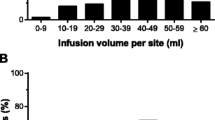Abstract
Replacement therapy, using subcutaneous infusions of γ-globulin, is being applied increasingly for antibody-deficient patients, as this form of treatment has been found to be related to a very low frequency of adverse systemic reactions. However, the uptake of IgG from subcutaneous tissue may be low, owing to degradation locally, especially for the IgG3 molecule. Therefore, the kinetics of IgG and IgG-subclass concentrations in the sera of 23 patients with common variable immunodeficiency was investigated during 18 months of subcutaneous infusions of γ-globulin (100 mg/kg/week). Seventeen patients were previously treated with intramuscular injections or intravenous infusions. The mean serum IgG level increased twice in the previously treated patients and four times in the previously untreated patients. A steady state was reached after 6 months if the subcutaneous infusions were given weekly and after 1 week if the patients were given daily infusions for 5 consecutive days and, thereafter, weekly infusions. The fractional catabolic rate of IgG (4.1–5.9% per day) was found to be at the lower limit reported for normal controls, if 100% bioavailability of the infused IgG was assumed. The fractional contents of IgG subclasses in the patients' serum IgG resembled the physiological pattern, with the exception of IgG4, which was not present in the γ-globulin preparations used. Significantly increased levels of IgG1 and -2 were seen in both previously treated and untreated patients during the treatment.
Similar content being viewed by others
References
Ochs HD, Morell A, Skvaril F, Fischer SH, Wedgwood RJ: Survival of IgG subclasses following administration of intravenous gammaglobulin in patients with primary immunodeficiency diseases.In Clinical Use of Intravenous Immunoglobulins, A Morell, UE Nydegerr (eds). Academic Press, London 1986
Mankarious S, Lee M, Fischer S, Pyun KH, Ochs HD, Oxelius VA, Wedgwood RJ: The half-lives of IgG subclasses and specific antibodies in patients with primary immunodeficiency who are receiving intravenously administered immunoglobulin. J Lab Clin Method 112:634–640, 1988
Fischer SH, Ochs HD, Wedgwood RJ, Skvaril F, Morell A, Hill HR, Schiffmann G, Corey M: Survival of antigenspecific antibody following administration of intravenous immunoglobulin in patients with primary immunodeficiency diseases. Monogr Allergy 23:225–235, 1988
Lee ML, Mankarious S, Ochs H, Fischer S, Wedgwood RJ: The pharmacokinetics of total IgG, IgG subclasses, and type specific antibodies in immunodeficient patients. Immunol Invest 20:193–198, 1991
Wedgwood RJ: The distribution and catabolism of IVIG preparations in immunodeficient patients.In Immunotherapy with Intravenous Immunoglobulin. London, Academic Press, 1991, pp 37–45
Chapel HM, Lee M: Immunoglobulin replacement in patients with chronic lymphocytic leukemia (CLL): Kinetics of immunoglobulin metabolism. J Clin Immunol 12:17–20, 1992
Smith GN, Griffiths B, Mollison D, Mollison PL: Uptake of IgG after intramuscular and subcutaneous injection. Lancet 1:1208–1212, 1972
Gardulf A, Hammarström L, Smith CIE: Home treatment of hypogammaglobulinaemia with subcutaneous gammaglobulin by rapid infusion. Lancet 338:162–166, 1991
Rosen FS, Wedgwood RJ, Eibl M, Griscelli C, Seligmann M, Aiuti F, Kishimoto T, Matsumoto S, Khakhalin LN, Hanson LÅ, Hitzig WH, Thompson RA, Cooper MD, Good RA, Waldmann TA. Primary immunodeficiency diseases. Report of a WHO scientific group. Immunodefic Rev 3:195, 1992
Waldmann TA, Strober W: Metabolism of immunoglobulins. Progr Allergy 13:1–110, 1969
Wintrobe MM, Lee GR, Boggs DR, Bithell TC, Foerster J, Athens JW, Lukens JN (eds): Clinical Hematology. Philadelphia, Lee and Fabiger, 1981
Skvaril F: Qualitative and quantitative aspects of IgG subclasses in I.V. immunoglobulin preparations.In Immunotherapy. A Guide to Immunoglobulin Prophylaxis and Therapy, UE Nydegger (ed). London, Academic Press, 1981, pp 113–122
Morell A, Terry WD, Waldmann TA: Metabolic properties of IgG subclasses in man. J Clin Invest 49:673–680, 1970
Gardulf A, Björell H, Gustafson R, Hammarström L, Smith CIE. The life situations of patients with primary antibody deficiency untreated or treated with subcutaneous gammaglobulin infusions. Clin Exp Immunol 92:200–204, 1993
Author information
Authors and Affiliations
Rights and permissions
About this article
Cite this article
Waniewski, J., Gardulf, A. & Hammarström, L. Bioavailability of γ-globulin after subcutaneous infusions in patients with common variable immunodeficiency. J Clin Immunol 14, 90–97 (1994). https://doi.org/10.1007/BF01541341
Accepted:
Issue Date:
DOI: https://doi.org/10.1007/BF01541341




